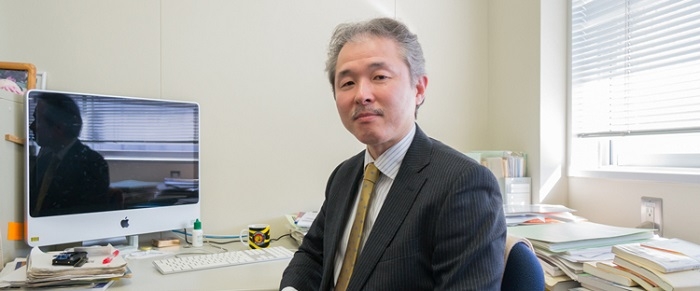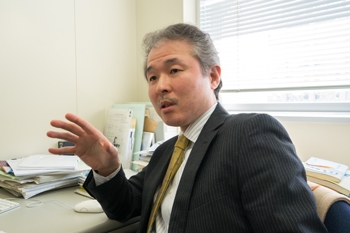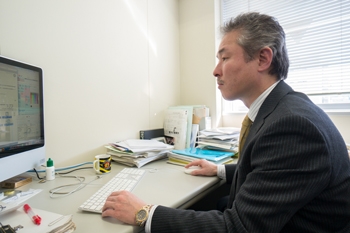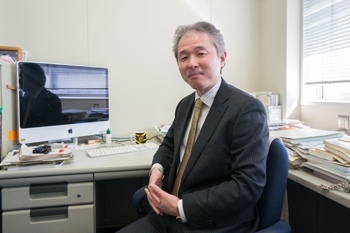A path toward a therapy! Success in reprogramming cells from patients with the premature aging disorder Werner syndrome into iPS cells

We talked to Associate Professor Akira Shimamoto of the Department of Cellular and Molecular Biology, Basic Life Sciences, Institute of Biomedical & Health Sciences.
(Interview: February 13, 2015 by PR Group)
Introduction
In November 2014, a research group led by Associate Professor Akira Shimamoto succeeded in reprogramming fibroblasts from patients with the premature aging disorder Werner syndrome (incidence of which is comparatively high among the Japanese population) into iPS cells (induced pluripotent stem cells). The outcomes of this study were published in the American online scientific journal PLOS ONE.
*The published paper can be found here.
The ability to produce iPS cells from a patient’s own cells holds out the promise of using these to manufacture the cells found in affected areas, so that the efficacies of a variety of compounds can be verified and new drugs developed. Moreover, it brings into view the potential for regenerative medicine, in which mutant genes in patients’ cells are fixed to turn them into healthy genes, which are then transplanted into the patient.
We talked to Associate Professor Shimamoto, who is pursuing research into Werner syndrome from the perspectives of both molecular and cellular biology, focusing on the theme of aging and regeneration.
What is Werner syndrome?
Werner syndrome is one type of progeroid syndrome. Not only do the skin and hair of patients with this syndrome look older than their actual age, but the acceleration of the aging process results in a greater decline in physical function than in healthy people, leaving them at greater risk of high blood pressure, diabetes, and cancer.
“In many cases, symptoms only appear after the age of 20. Hair progressively turns white or falls out, but the patient simply doesn’t realize that this is an illness. Often, they are only diagnosed with Werner syndrome after seeing a physician because they have developed cataracts (which are usually more common in those aged 45 or over) at a young age.”
Moreover, Associate Professor Shimamoto points out that one must not overlook the very high incidence in Japan, with about 80% of reported cases worldwide found in the Japanese population. Apparently, 1 in 100-200 Japanese people carries a mutation in the WRN gene, which is believed to be the gene that controls aging and is the cause of the syndrome, while onset has the potential to occur in 1 in 40,000 people.
No time lost in focusing on iPS cells!
An encounter with Werner syndrome while working at the joint public-private AGENE Research Institute about 20 years ago, after completing his doctoral program, was the catalyst for Associate Professor Shimamoto to begin tackling this intractable disease.
“At the time, the gene responsible for Werner syndrome was yet to be discovered, so I immersed myself in my research, hoping to identify the gene as soon as possible and find some kind of clue to a therapy. Then, once the causative gene was identified, we realized that the collapse of the structural maintenance of chromosomes appeared to be involved in aging and a variety of diseases,” he says, looking back.
Then, after reading a paper about the success of the group led by Professor Shinya Yamanaka of Kyoto University in generating iPS cells, Associate Professor Shimamoto hit upon a hypothesis:
“Perhaps the abnormalities in the cells of Werner syndrome patients could be conquered using iPS cells.”

Associate Professor Shimamoto talks about his research findings.
Conquering abnormalities with iPS cells, which do not age
When the cells of a patient suffering from Werner syndrome are cultured, a variety of genes associated with aging manifest themselves from the very first stage and the cells quickly age. Moreover, within the patient’s cells, abnormalities occur in the telomeres, which play a part in protecting the ends of chromosomes, and the telomeres themselves quickly become shorter, causing frequent chromosomal abnormalities.
At the same time, iPS cells are created by introducing four types of gene discovered by Professor Yamanaka et al. into somatic cells derived from human skin, generating cells with the ability to proliferate (divide) infinitely, which have simultaneously been reprogrammed into an undifferentiated state. To put it another way, they are cells that do not age. The reprogramming phenomenon that occurs in the process of the somatic cells becoming iPS cells shuts out the genes associated with aging, so they cease to be expressed. Moreover, Associate Professor Shimamoto noted another crucial point, namely the activation of the enzyme telomerase, which maintains the telomeres associated with cell division.
“We had already discovered from previous experiments that introducing the telomere-lengthening enzyme telomerase into the patient’s cells prevents the premature cessation of cell division (which is the cause of the patient’s premature aging), thereby extending the patient’s life expectancy. One of the “reprogramming” phenomena that take place in the process of iPS cell generation results in cells becoming undifferentiated and pluripotent, which means that they have the capacity to become differentiated into a variety of cells. We thought that if these four genes were introduced into a patient’s cells in this way, telomerase would be activated, extending the number of rounds of cell division and enabling us to overcome the problem of the premature cessation of cell division.”
Hypothesis borne out splendidly!
Once he formed his hypothesis, Associate Professor Shimamoto obtained cells from patients via university physicians who had helped him during his time at the AGENE Research Institute.
“When I spoke to university hospital physicians who had diagnosed Werner syndrome in their patients and asked if they could provide me with cells from those patients so that I could produce iPS cells, they obtained the consent of their patients, enabling me to acquire the cells,” he says, citing this as one of the factors behind his rapid success in producing iPS cells.
The research group led by Associate Professor Shimamoto succeeded in producing iPS cells derived from each patient by introducing the four types of gene used in the production of iPS cells into fibroblasts from the skin of patients with Werner syndrome. The iPS cells produced were then cultured in continuous passages over two years. When iPS cells created from healthy individuals were compared with those produced from the patients, the results accorded with the associate professor’s hypothesis that they had the same undifferentiated state and pluripotency, and had acquired the capacity for infinite cell division.
“We believe that, in the iPS cells, the telomere-lengthening enzyme (telomerase), which is not activated even in the somatic cells of healthy individuals, activated the functions of the telomeres, resulting in the extension of the life expectancy of the patient’s cells and the maintenance of their undifferentiated state and pluripotency.”
Moreover, they discovered that the expression of distinctive genes associated with aging in the cells of patients with Werner syndrome was curbed to the same degree as in the iPS cells of healthy individuals, and that the reprogramming of the patients’ cells had rejuvenated the cells in which aging had progressed. In addition, the frequency of chromosomal abnormalities in the iPS cells of Werner syndrome patients remained much lower than that in the original fibroblasts, even after repeated culturing over 120 continuous passages. Hopes are growing that “unraveling this mechanism could lead to the establishment of measures to prevent not only Werner syndrome, but also the aging process that inevitably affects everyone.”

Associate Professor Shimamoto checks his research data.
The biggest problem is the fragility of the skin.
The average life expectancy of patients with Werner syndrome is growing by the year, it seems.
“When I began my research 20 years ago, the average life expectancy was 45-50. Today, thanks to the development of drugs for the diabetes and hypertension to which Werner syndrome patients are prone, the average life expectancy has increased and some have even made it to the age of 64.”
However, living longer brings its own problems.
“The biggest problem for patients is the fragility of their skin. When they near the age of 50, their skin develops fissures if they suffer a blow and these simply don’t heal.”
Called skin ulceration, this symptom is particularly common on the heels and other areas with little subcutaneous fat and apparently causes intense pain.
“Initially, the pain can be reduced to some extent with analgesics, but as the symptom progresses, the drugs gradually stop being effective. Ignoring skin ulceration gives rise to the risk of infectious disease. Accordingly, as a last resort, the leg may be amputated below the knee. This may free the patient from the intense pain. Nevertheless, it’s a difficult choice for patients. Some patients choose to battle on, enduring the pain,” says the associate professor, describing the harsh reality.
Establishing therapies for skin ulceration should be the priority.
If the leg is amputated, the patient’s quality of life (QOL) declines.
“Increasing the QOL of patients plagued by skin ulceration should be the first priority,” he stresses.
Currently, in partnership with Professor Takashi Yamamoto (Hiroshima University Graduate School of Science), who specializes in genome editing, Associate Professor Shimamoto is conducting research aimed at bringing regenerative medicine to fruition by fixing mutated genes in patients’ iPS cells, creating skin from cells with normal genes, and transplanting these into areas of skin ulceration.
Relating his aspirations for the future, he says, “While the path to its realization might be a long one, I want to establish a therapy to combat skin ulceration in order to alleviate the burden on patients as much as possible.”
Finding strength in a sense of curiosity
Above all else, as a scientist, “I take care to maintain a sense of curiosity,” he says.
“Wondering about things shows you the problems that need solving, which propels your research forward. When students encounter science, I’d like them to get into the habit of being curious about everything.”
When advising students, the associate professor attaches importance to developing their ability to come up with ideas.
He asks them, “What do you think you should do next?” and “What do you conclude from these data?” in order to encourage students to think independently. He strives to bring out students’ innate abilities through these questions.
“I always share my joy with students, no matter how small the success that has been achieved in an experiment,” he says, providing a glimpse of his zeal not only as a researcher, but also as an educator.

Afterword
In the words of Associate Professor Shimamoto, “Above all else, it’s important for researchers and scientists to maintain a sense of curiosity.” From there, they identify challenges and seek to resolve them, overcoming various difficulties along the way. This is crucial not only in the field of science, but also in all other fields. Although he replied that “the path to its realization might be a long one,” I had the feeling that Associate Professor Shimamoto’s passion for research will lead to the establishment of a therapy for the intractable premature aging disorder Werner syndrome. (N)


 Home
Home

